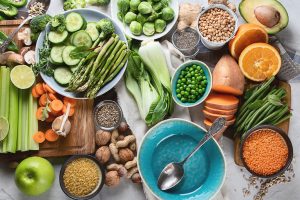Transform Your Health with a Plant-Powered Living Foods Diet

Introduction: Plant-Powered Living Foods Diet
Understanding the Basics
The Plant-Powered Living Foods Diet revolves around the utilization of whole, unprocessed plant foods, emphasizing raw fruits, vegetables, nuts, seeds, and sprouts. This lifestyle not only focuses on what you eat, but also where those foods come from and how they are prepared. By embracing minimally processed ingredients, individuals can experience a vibrant range of flavors and textures while providing their bodies with essential nutrients. For many, the journey into this vibrant world of plant-based living starts with small, manageable changes. For example, swapping out a traditional breakfast of sugary cereal for a refreshing smoothie packed with greens can significantly shift one’s daily nutrient intake. By understanding the foundational principles of this diet, individuals can enhance their culinary experiences and transform their overall well-being.
- Transform Your Health with a Plant-Powered Living Foods Diet
- Introduction: Plant-Powered Living Foods Diet
- Understanding the Basics
- Benefits of Plant-Based Living Foods
- Getting Started with a Plant-Powered Living Foods Diet
- Transitioning to a Plant-Based Lifestyle
- Essential Nutrients to Focus on
- Designing Your Plant-Powered Meals
- Incorporating a Variety of Fruits and Vegetables
- Including Whole Grains and Legumes
- The Impact of a Plant-Powered Living Foods Diet on Health
- Improved Digestion and Gut Health
- Boosting Energy Levels and Vitality
- Building a Sustainable Plant-Based Lifestyle
- Tips for Eating Out on a Plant-Based Diet
- Plant-Powered Living Foods Diet for the Long Term
Benefits of Plant-Based Living Foods
The advantages of adopting a Plant-Powered Living Foods Diet are numerous and impactful. Here’s a brief overview of some benefits that catch many people’s attention:
- Weight Management: Many who transition to a plant-based lifestyle experience weight loss due to the high fiber content in plant foods, which keeps them feeling full longer.
- Enhanced Nutrient Intake: This diet is rich in vitamins, minerals, and antioxidants, offering a plethora of nutrients that are often lacking in standard diets.
- Disease Prevention: Studies have shown that those who consume predominantly plant-based foods have a lower risk of chronic diseases, including heart disease, diabetes, and certain types of cancer.
- Environmental Impact: A plant-powered diet contributes to environmental sustainability by reducing one’s carbon footprint. The resources required to produce plant-based foods are significantly less than those needed for meat and dairy.
Transitioning to a Plant-Powered Living Foods Diet is not merely a change in diet; it is a shift towards a more health-conscious and environmentally friendly way of life. As individuals begin this journey, they often discover new preferences and broaden their palate. For instance, exploring exotic vegetables or experimenting with different cooking methods can make healthy eating exciting and enjoyable. Overall, embracing this lifestyle can lead to better health, enhanced energy levels, and a stronger connection to the nourishment that nature provides.
Getting Started with a Plant-Powered Living Foods Diet
Transitioning to a Plant-Based Lifestyle
Embarking on a Plant-Powered Living Foods Diet can seem daunting, especially for those accustomed to more conventional eating habits. However, transitioning to this lifestyle can be a smooth and enjoyable journey with the right approach. To kickstart this transition, consider taking gradual steps. Begin by identifying one or two meal times each week to incorporate plant-based options. For instance, instead of a meat-based stir-fry, try swapping in tofu, tempeh, or a medley of colorful veggies. As someone who once struggled with making the switch, I found that replacing one meal a day made it less overwhelming. Soon, I was experimenting with different recipes and discovering new favorites! Here are some simple strategies to help you ease into a plant-based lifestyle:
- Start Small: Focus on meatless days or meals, gradually increasing the frequency as you grow more comfortable.
- Explore New Recipes: Look for inspiration in cookbooks, online blogs, or cooking classes. This can rekindle the joy of cooking!
- Plan Your Meals: Meal prepping helps ensure that healthy options are readily available, reducing the temptation of grabbing less nutritious alternatives.
Essential Nutrients to Focus on
As you transition, it’s crucial to pay attention to the essential nutrients typically found in animal products. Incorporating a variety of plant-based foods helps ensure balanced nutrition. Here are key nutrients to focus on:
- Protein: Include good sources like lentils, chickpeas, quinoa, and nuts to keep your energy levels steady.
- Iron: Plant-based sources such as spinach, legumes, and fortified cereals can help meet your iron needs. Pairing them with vitamin C-rich foods enhances absorption.
- Vitamin B12: As this is predominantly found in animal products, consider fortified foods or a B12 supplement if you adopt a strict plant-based regimen.
- Omega-3 Fatty Acids: Flaxseeds, chia seeds, and walnuts are fantastic plant sources to support heart and brain health.
By remaining mindful of these nutrients, individuals can embrace their new plant-powered lifestyle confidently, knowing they are nourishing their bodies effectively. With time and practice, this diet can become a natural and enjoyable part of daily life.
Designing Your Plant-Powered Meals
Incorporating a Variety of Fruits and Vegetables
Having established the foundational elements of transitioning to a Plant-Powered Living Foods Diet, the next exciting step is designing meals that celebrate the vibrancy of fruits and vegetables. The appeal of a plant-based diet lies in its endless variety! When planning meals, aim for a colorful plate. Each hue represents different nutrients and antioxidants beneficial to your health. For example, dark leafy greens are packed with iron and calcium, while orange vegetables like carrots and sweet potatoes are rich in beta-carotene. Here are a few practical tips to maximize your fruit and vegetable intake:
- Create Rainbow Plates: Aim to include something from each color group—red (tomatoes, red peppers), orange (carrots, orange bell peppers), yellow (corn, yellow squash), green (kale, broccoli), blue/purple (blueberries, eggplant), and white (garlic, onions).
- Experiment with Textures: Combine crunchy raw veggies with tender roasted ones to keep your meals interesting. A perfect example is pairing raw bell pepper strips with roasted zucchini and sun-dried tomatoes.
- Season with Herbs and Spices: Fresh herbs like basil or cilantro can enhance the flavor of fruits and vegetables, making dishes both nutritious and flavorful.
Including Whole Grains and Legumes
Alongside fruits and vegetables, whole grains and legumes play a vital role in creating well-rounded plant-powered meals. They provide essential fibers, proteins, and minerals that keep you energized and satisfied.
- Whole Grains: Opting for whole grains such as quinoa, brown rice, bulgur, or oats over refined grains ensures that you’re receiving more nutrients and fiber. For those who love to cook, preparing a big batch of quinoa at the beginning of the week can encourage it to find its way into various meals—from salads to stir-fries.
- Legumes: Beans, lentils, and peas are fantastic plant proteins that also offer fiber for digestive health. Consider making a hearty lentil soup or adding chickpeas to a salad for a protein boost. I used to think beans were bland until I discovered the rich flavors of spices, which transformed my simple dals into mouthwatering dishes.
By combining a variety of fruits, vegetables, whole grains, and legumes, you can create meals that are not only satisfying but also vibrant and colorful. This approach ensures that your diet is balanced, nutrient-dense, and truly enjoyable. Embracing creativity in meal design can make each dining experience feel like an adventure, keeping you enthusiastic about your plant-based journey!
The Impact of a Plant-Powered Living Foods Diet on Health
Improved Digestion and Gut Health
Transitioning to a Plant-Powered Living Foods Diet has profound effects on digestion and overall gut health. The abundance of fiber found in fruits, vegetables, whole grains, and legumes plays a crucial role in promoting a healthy digestive system. Fiber not only aids in regular bowel movements, but it also acts as a prebiotic, providing nourishment for beneficial gut bacteria. After incorporating more plant-based foods into my meals, I noticed a significant improvement in my digestion. Gone were the feelings of bloating and discomfort that occasionally followed heavier meals. Instead, I experienced consistency and comfort, making me more aware of the food I was consuming. Here are some key benefits of improved digestion through a plant-powered diet:
- Regular Bowel Movements: A higher intake of fiber enhances the body’s ability to regulate digestive processes.
- Reduced Gastrointestinal Issues: Many people report fewer digestive troubles, such as irritable bowel syndrome (IBS), when eating plant-based meals.
- Enhanced Nutrient Absorption: A healthy gut promotes better absorption of essential nutrients, which contributes to overall well-being.
Boosting Energy Levels and Vitality
Another noteworthy benefit of a Plant-Powered Living Foods Diet is the surge of energy and vitality it provides. Due to the rich nutrient profile of plant foods, individuals often experience heightened energy levels throughout the day. This newfound vitality can transform daily routines and activities. For instance, after shifting my breakfast from a sugar-laden cereal to a nutrient-packed smoothie with spinach, banana, and nut butter, I found myself more alert and energized through the morning. Here are some reasons why a plant-powered diet can boost energy:
- Sustained Energy Levels: Whole grains and legumes provide complex carbohydrates that release energy gradually, preventing energy crashes often associated with sugary diets.
- Rich in Nutrients: The plethora of vitamins and minerals in fruits and vegetables supports various bodily functions, including metabolism and energy production.
- Reduced Inflammation: Many plant foods contain antioxidants and compounds that may help lower inflammation, leading to increased overall energy and vitality.
By embracing a Plant-Powered Living Foods Diet, individuals can experience significant improvements in their digestive health and overall energy levels. With these changes, routines become more dynamic and enjoyable, making the benefits of this lifestyle even more robust and appealing. As one embraces this journey, they may find themselves not just feeling good, but thriving!
Building a Sustainable Plant-Based Lifestyle
Tips for Eating Out on a Plant-Based Diet
As individuals embrace a Plant-Powered Living Foods Diet, the transition often poses challenges, particularly when eating out. Social gatherings and dining experiences can sometimes feel daunting for those new to plant-based eating. However, with a little preparation and confidence, dining out can be a delightful adventure! Here are some practical tips for navigating restaurant menus while staying true to a plant-based lifestyle:
- Research the Menu in Advance: Many restaurants post their menus online. By reviewing the offerings beforehand, you can identify plant-based options or even call ahead to inquire about modifications.
- Ask Questions: Don’t hesitate to ask the server how dishes are prepared. Many restaurants are more than willing to accommodate dietary preferences, such as substituting meat with veggies or beans.
- Focus on Sides: Sometimes the sides can be the stars of the meal! Look for vegetable-based appetizers, salads, or whole grain sides that can create a satisfying and balanced meal.
For example, during a recent outing with friends, I discovered a lovely Mediterranean restaurant that served a delicious quinoa salad packed with roasted vegetables and a drizzle of tahini. It became a go-to spot because of its flavorful plant-based options, which catered delightfully to my dietary choices.
Plant-Powered Living Foods Diet for the Long Term
Building a sustainable Plant-Powered Living Foods Diet isn’t just about making changes; it’s about integrating these practices into daily life for the long haul. Here are some strategies for ensuring longevity and enjoyment in this lifestyle:
- Diversify Your Diet: Continuously experiment with different fruits, vegetables, grains, and legumes. Your taste buds will remain excited, and you’ll prevent boredom with your meals.
- Plan for Success: Establish a meal prep routine to ensure healthy options are always available. Preparing meals in advance makes it easier to stick with the lifestyle, even on busy days.
- Stay Connected: Join communities or groups that promote plant-based living. Sharing recipes, experiences, and advice can enhance motivation and provide inspiration.
Reflecting on my journey, I’ve found that the more I learn about plant-based foods, the more excited I become about trying new recipes and flavors. It’s about cultivating a curious mindset that embraces sustainability and health. In summary, making a Plant-Powered Living Foods Diet a long-term commitment is achievable with the right mindset and strategies. By approaching it with enthusiasm, creativity, and connection, individuals can enjoy robust health, delicious meals, and a sustainable lifestyle that truly nourishes both body and soul.




